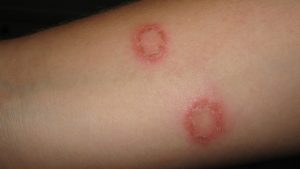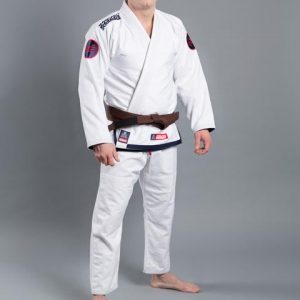Alternatively titled: wash your belt, you filthy animals!
Accidental injuries in BJJ are rarely serious, particularly when compared to other contact or combat sports. Injuries occur, of course, but BJJ does not present any real elevated risk of serious injury. However, there are dangers that can be mitigated when training, and one of those risks is the risk of infection. In this post, I won’t include any graphic images of what can happen when someone gets a dermal infection as a result of staphylococcus, strepylcooccus, or any other microbe that invades the skin: if you’re a visual learner, any of these infections can be seen on Google Images. I will go through what an infection is, how they’re treated, the most common ones in BJJ, and what you can do to avoid them, however. I’m also going to include some practical information about basic care for both gi and no-gi apparel.
About Infections
In the context of BJJ, wrestling, and other close-contact sports, the type of infections that we worry about most are bacterial infections. Viral infections are spread around the gym, of course, because jiu jitsu necessitates touching, but bacterial infections spread from skin-to-skin contact are of particular concern.
There are also fungal infections that can be spread around the gym as well: issues like ringworm can become endemic in the academy if untreated, particularly as they spread so easily. Ringworm is itchy, extremely contagious, and an all-around pain to deal with, but it rarely causes major health issues. Ringworm is commonly found in children, but the close-contact environment of jiu jitsu, wrestling, gymnastics, and other sports where skin is exposed also sometimes fosters outbreaks.

The real culprits for infection problems in the jiu jitsu academy are bacterial infections. Strep and staph are two of the more common bacterial infections that can occur— these bacteria often live on the skin (and in the nose, funnily enough), but become a problem when they enter the skin through a cut or tear.
 Taken from Dr. Hussein Abulfotouh
Taken from Dr. Hussein Abulfotouh
Some strains of bacteria can be treated with antibiotics, but antibiotic-resistant microbes are becoming frighteningly common, and an infection can become serious and life-threatening very quickly. But now that all the doom and gloom is done, and I’ve frightened everyone sufficiently, let’s talk about what we can do to avoid infections and keep the academy a clean, healthy place for everyone.
Preventing Infections
Preventing infections is partially our responsibility, and partially yours. To prevent infections at the academy, we:
- Wash and clean the mats after training
- Clean all shared spaces regularly
- Clean our gis, belts, and other equipment after every use
- Replace mats regularly when they become worn, dirty, or impossible to clean.
- Remain vigilant when teaching students, watching for potential infections.
Your responsibilities are similar:
- Clean your gi and belt after every training session
- Clean all spandex regularly.
- DO NOT train if you have any kind of infection at all– no one wants to come down with the flu after training, and absolutely no one likes ringworm or MRSA.
- If you have an open wound that appears red, hot, inflamed, itchy, or weepy, go immediately to A&E for treatment. Infections progress quickly, and the faster they are treated, the better the prognosis.

So with no further ado, let’s get on to… cleaning and caring for your jiu jitsu equipment.
Cleaning and Caring for a Gi
We’re relatively lucky in jiu jitsu– gis are easy to clean, and they don’t really have any nooks or crannies where microbes can hide through a wash cycle. That said, like any athlete, jiu jitsu practitioners tend to have some really strange superstitions. I’ve been a black belt a number of years, and let me tell you, I’ve never once washed away any of my knowledge by washing my belt. Wash your belt, people!
Gis and belts are primarily made of cotton, although there are some that are made from other materials like hemp. Cotton tends to shrink in the washer and in the dryer if washed on hot, so washing on warm or cold with extra agitation is a good way to ensure that your gi and belt are clean without shrinking your gi too much.

Tom and I tend to hang dry our gis, which, depending on the humidity and temperature, can take anything from a few days to a week. If you do hang dry, hanging them in a place with good airflow will keep them from smelling musty when they dry. Some gis are advertised as “pre-shrunk,” but I’ve personally had middling success with these claims. Sometimes gis don’t shrink at all; sometimes they shrink more than a size. Unfortunately, there’s no real way to tell whether the gi will shrink other than asking someone who has bought the same gi.
Generally, this means that if you’re training three times per week, you’ll need at least two gis. Gis have a shelf life as well: a gi worn regularly will last anywhere between one and two years, barring any kind of ripping incident. Gis also come in different “weaves:” this refers to the thickness of the fabric. A single-weave gi will be extremely light and compact, but it will also wear out faster than a double or pearl-weave gi. The heavier the gi, the longer it will take to dry, so always make sure to plan your washing accordingly!
Cleaning and Caring for Spandex (Spats, Rash Guards, etc.)
Usually, in jiu jitsu, spandex is found in apparel like rash guards, spats, and sometimes spandex shorts. Spandex is also found in sports bras and other athletic tops.


Generally, spats and rash guards are worn for no-gi, but they can also be worn under the gi. Washing regimens should be the same regardless of how the apparel was worn.
Spandex is similar in that it must be washed after every training session, but I always wash my spandex on warm to hot, and I frequently use a tumble dryer for my spandex rather than hang drying. However, hang drying spandex is a much faster process than hang-drying a gi, but it is even more important that you hang spandex in a place with good airflow, because spandex can and does become more smelly than a gi much more quickly.
Permanently Smelly Rash Guards
There is something about the alchemy of male sweat and spandex: over time, the combination of man-sweat and spandex becomes overwhelmingly stinky. Sometimes, you’ll find that you wash your spandex and it smells fine– but as soon as you put it on, it begins to smell again. You can sometimes save your rash guard by soaking it overnight in vinegar and water: I usually use a ratio of 3:1 for water: vinegar when I have to soak rash guards. After I soak the rash guards, I usually rinse them well, then run them through the wash as normal. If they still smell, it’s time for retirement– remember, if you can smell yourself, everyone else around you can smell you as well!
We’re invested in making sure our training environment is safe in every way, and that includes creating a clean environment for the students. If you’d like more information, this post, written by a microbiologist, is an excellent primer on the science of infection and how to protect yourself from infection in an environment like a jiu jitsu academy.